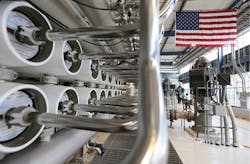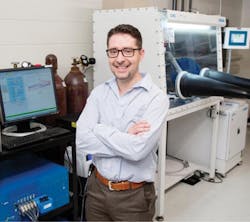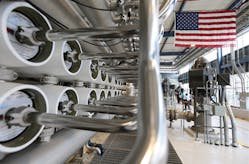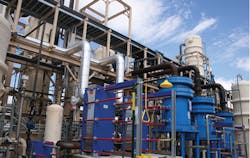Initiatives seek to make water treatment options more cost- and energy-efficient.
By Alanna Maya
Desalination can be used to treat seawater, brackish water, and contaminated water for use in municipal water supplies or to reclaim contaminated water, making it an ideal solution for areas where fresh water resources are limited. But with energy accounting for anywhere from one-third to more than half of a plant’s operating costs, professional organizations and researchers are looking at ways to reduce energy consumption. Finding a more energy-efficient way toward desalination could mean an unlimited supply of freshwater resources in the future.
According to a joint statement by the American Membrane Technology Association (AMTA) and the Bureau of Reclamation, “The need to reduce the cost, energy usage and environmental impacts in advanced water treatment and desalination [requires] a focus on innovation of new systems or optimization of existing technology.”
To this end, the two organizations are offering four awards of more than $11,000 each for development of “novel approaches or processes to desalinate water in a way that reduces primary energy use.” Other agencies are also seeking out ways to foster innovation in this area.
Illinois mechanical science and engineering professor Kyle Smith and his co-authors have shown that a new battery-like water desalination device could help provide fresh water to a variety of regions efficiently and economically. Photo by L. Brian Stauffer.
Recently, the U.S. Department of Energy (DOE) announced $15 million in congressionally-directed funding for solar desalination technologies. The Solar Energy Technologies Office will award between $500,000 and $5 million to 7 to 10 projects that explore early-stage technologies with the prospect of significantly reducing the cost of desalination through solar thermal energy.
“By integrating solar technology with desalination, we can dramatically lower the cost of creating clean water,” said Charlie Gay, Solar Energy Technologies Office director, in a press release.
According to the DOE, solar power, either in the form of electricity or thermal power, has the potential to dramatically reduce the cost of desalination. With electricity costs accounting for up to half of the operating expenses for desalination projects, this is in important area of research. Another is in the area of concentrate management.
The Kay Bailey Hutchison Desalination Plant recently entered into a utility partnership with Enviro Water Minerals to expand upon its desalination capacity and treatment for brine concentrate. Photo courtesy El Paso Water.
A Decade of Innovation
Since opening in 2007, the Kay Bailey Hutchison (KBH) Desalination Plant in El Paso, Texas, has become a model for places around the globe facing serious water supply challenges. The plant has produced 17 billion gallons of water since beginning operations. Recently, water sector leaders and researchers gathered to celebrate the desalination plant on its 10th anniversary.
“Given the vast brackish groundwater resources, desalination has become an important part of the puzzle that will ensure we have a vital water future for this community, including for our kids, grandchildren and anybody that wants to live here in the future,” said John Balliew, president and CEO of El Paso Water.
A new utility partnership between El Paso Water and Enviro Water Minerals (EWM) will result in what is being called “the first full-recovery desalination facility.” It includes a new, neighboring facility that will take the plant’s brine concentrate — which would otherwise go through a deep well injection process — and turn the salts and minerals into industrial-grade commercial products. EWM will then sell fresh drinking water back to the utility at a rate of 2 million gallons per day at full capacity.
The Texas Coalition for Affordable Power released a report this summer on the declining costs of energy in Texas and credited a competitive market, use of wind, solar and nuclear power, and the price of natural gas as major factors. At the KBH plant’s anniversary celebration, Paul Choules, president of the Texas Desalination Association, spoke about taking advantage of the lower costs of energy in Texas.
“The reality is in the state of Texas we should be able to desalinate cheaper than anywhere in the world, and one of the major reasons for that is the cost of energy,” Choules said.
Guy Carpenter, president of the national WateReuse Association, said that for inland desalination applications, brine management is the chief barrier nationwide. He said utilities will continue to have to deal with the expensive options for removal, such as evaporation, thermal brine concentration and deep well injection.
Enviro Water Minerals’ concentration system processes the diluted chemicals manufactured in the desalination plant. Photo courtesy El Paso Water.
In a statement, Barbara Martin, director of engineering and Technical Services for the American Water Works Association, said innovations at El Paso Water could bring about more widespread use of desalination in the industry.
El Paso Water can “provide a blueprint for utilities to follow and hopefully increase the use of desalination technology in the future,” Martin said.
Economically Desirable and Energy Efficient
Engineers at the University of Illinois have developed a saltwater desalination process that is potentially cheaper than reverse osmosis and borrows from battery technology. “As demand for diminishing clean water sources increases, the need for desalination of lower-salinity brackish water from inland and industrial sources will increase,” Illinois mechanical science and engineering professor Kyle Smith and his co-authors said.
Previously, Smith and his team used theoretical modeling to show that technology used in sodium-ion batteries may efficiently desalinate seawater. Their theory states that by using electrodes that contain sodium and chloride ions, salt is drawn out and held in a chamber separate from the purified water.
“In our new study, we constructed and experimented with a battery-like device that uses electrodes made from a different material. That material can remove from brackish water not only sodium ions but also potassium, calcium, magnesium and others,” Smith said in a statement. “This is important because salt and brackish waters do not contain just sodium chloride. It is often in a mix with other salts like potassium, calcium and mangnesium chloride.”
The new material is a chemical analog to the compound Prussian blue — the intense pigment used in ink for blueprints. It works by taking and holding positively charged ions like sodium within its crystal structure, Smith said.
“The competition between the rate of diffusion of the positively charged ion within the crystal structure and the volume at which the ions can be stored creates a trap-like structure,” Smith said. “They go in easily but can’t get out.”
There are other materials that can secure positive ions, but the Prussian blue analog has an additional benefit: it is potentially very cheap to source.
“To make a technology like this economically feasible, it needs to be cheap and, ideally, have some value-added benefit,” Smith said. “By showing that our device works well with lower-salinity waters, the door for use with inland brackish waters and possibly industrial wastewater has opened.”
Smith and his co-authors show that the amount of salt removal is sufficient to demonstrate their concept using brackish water. However, further research is needed to determine how the removal of salts from higher-salinity seawater and wastewater will impact that energy efficiency. WW
Alanna Maya is Assistant Editor for WaterWorld and Industrial WaterWorld Magazines. Email her at [email protected].







